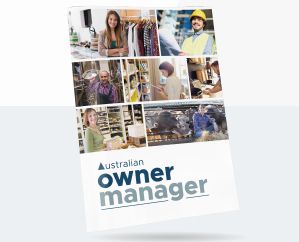Owner Manager Program facilitator and bestselling author Mandy Johnson outlines the 7 steps you can take right now to become a more engaging leader in your own business.
In my early twenties I had the dubious fortune of becoming the leader of a travel agency chain’s worst- performing national store. It was a place where staff had stand-up arguments, took constant sick days, alienated clients and often quit. Twelve months later, the perpetually loss-making store was profitable and the staff had won five company achievement awards. Yet I didn’t realise the true level of my team’s engagement until the day one of the employees missed the bank, hid $20,000 in cash in the bottom of a rubbish bin and then accidentally threw it out. By the time I arrived at work, the team had already purchased rubber gloves and arranged a temp, while they rushed to the nearest rubbish dump. Hours of digging through smelly trash later, the bag of money was unearthed and we celebrated like it was the new millennium.
Yet these employees are in the minority. According to a Gallup global study only 13% of people are actually engaged in their work. Here then are seven steps to more engaging leadership:
- Get the team size right
It is very difficult for a business owner to engage and inspire people when they have too many employees to manage. In my first book Family, Village, Tribe I explain how global travel retailer Flight Centre grew from a single store to over 3000 stores and became a $4 billion corporation, by utilising smaller, more focused teams. The company found that once team size grew beyond seven, they were harder to manage, people became less engaged, staff turnover increased and productivity and profits dropped right off. You can see this at dinner parties when the group gets beyond 7 or so, people split off and start to talk in separate groups. This strategy may seem counterintuitive as the upfront cost of more team leaders is higher, yet the return in engagement and productivity far exceeds the extra costs. Flight Centre almost doubled its profits in a single year after it implemented the ‘family, village, tribe’ philosophy. Gore, Virgin, Semco, Spotify, and Atlassian are other companies that have now adopted this system and have also achieved great success. - Hire the ‘right-fit’ people in the first place
Trying to engage employees who are unsuitable for the role or the organization is like trying to force a square peg into a round hole. As global jewelry retailer, Michael Hill found, improving their hiring practices halved their staff turnover in less than 12 months. Unfortunately, many organisations give little – or the wrong focus – to hiring, or appoint sub-standard recruits and then become trapped in a cycle of low engagement and productivity and high staff turnover. I’ve written a whole book on how to hire the right people, but the main criterion is to look at attributes like past achievement and examples of perseverance, in addition to skills and cultural fit. - Hold Monthly One-On-Ones
Imagine a coach who only met with his professional athletes once or twice a year and reeled off a long list of everything the athlete was doing wrong. It sounds insane, yet this is the norm for many business owners and leaders, who conduct once or twice-yearly performance appraisals. Of all the talent management strategies I’ve seen or used to build engagement and high performance, the monthly one-on-one system is a stand-out. This is when a leader takes time out to have a productive reflective discussion with each employee and create an individual action plan. Not only does this process nurture the vital bond between an employee and his immediate supervisor, but as a study by Bersin and Associates found, a monthly action plan alone results in twice the revenue per employee and a 27% lower staff turnover rate. Tech company Atlassian makes a great case study. When executives discovered that their twice-yearly staff appraisals led to disengagement, they implemented these monthly check-ins. The result: extraordinarily high engagement scores of 87% and ‘Best Employer’ awards soon followed. - Reduce Bureaucracy
When the US army was experiencing disengagement and high turnover of its most promising leaders they thought it was because these leaders didn’t like the possibility of active war deployment. Yet when a researcher conducted a study he found that the root cause of this disengagement was the increasing levels of bureaucracy. No one likes doing worthless activities. With work hours escalating in developed countries, time is now a valuable commodity and wasting it is often a big factor in employee disengagement. Leaders who can improve even just one piece of double-handling a month can achieve much better results. - Praise and Reward Excellence on a Regular Basis
In a 2012 Globoforce survey, 47% of workers gave ‘not being recognised for their efforts’ as one of the main reasons for leaving their last job. Turn this around and there’s a serious prize on offer for those business owners who get it right. The first step is to have an objective intelligent way to measure achievement. This is relatively easy in sales roles but for other roles needs some application. By aligning KPIs with desired business outcomes and making them monthly and realistic, business owners and leaders can create fun and rewarding initiatives that build excitement and anticipation for their people. - Brightness of Future (BOF)
I have asked every person I ever interviewed why they were looking to leave their existing employer. More than 75% of them stated they couldn’t see any future; there was simply nowhere for them to go; no way for them to grow and develop; no brightness of future. Business owners can attack this problem by creating an annual BOF plan with each of their people. This can cover a wide range of areas such as personalized training and development; potential awards they might aim for; promotional prospects; opportunities to mentor or be mentored; involvement in new projects and initiatives; profit sharing; more flexible shift times or days in lieu, and so on. With the plan reviewed regularly during monthly one-on-ones, people stay more engaged and staff turnover is reduced. - Have Fun
In the ‘rubbish dump’ example, I had become a store manager after travelling and working as a tour leader for three years. In that period I learnt that if my tour passengers had fun, they scored the tour high on the satisfaction rating. So I applied the same underlying principle of ‘let’s have fun’ to my new business and achieved the same results. When people are enjoying themselves – be it social events, weekly competitions, morning boredom-breakers or team challenges – then they become more engaged. They progress much faster from ‘forming’ to ‘performing’, their productivity levels go sky-high and no-one wants to leave the new winning team. As baseballer Babe Ruth once said, ‘You may have the greatest bunch of individual stars in the world but if they don’t play together, the club won’t be worth a dime.’
To accomplish all of the above, business owners and leaders require a positive pro-active attitude towards their people. This often requires a complete mental flip. Great leaders recognize that it is not their people who are lucky to have a job, but they themselves who are lucky to have great people invest their skills into the company. As John Paul Getty, the rich American industrialist once said, ‘The employer generally gets the employees he deserves’. In practice, I’ve found this to be true every time.
Mandy Johnson is a best-selling author; a founder of global travel retailer Flight Centre’s start-up UK operation; and a facilitator for the Australian Owner Manager Program – the only Australian educational program designed exclusively for owners of mid-size private companies $3m to $100m covering a range of essential business topics including people management, strategy, finance, lean design, health and wellbeing and many more. More than 30 business experts and 2 dedicated program facilitators will educate you and push the boundaries of your business and challenge you in ways that will make you see things differently.







